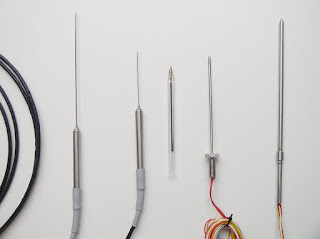What is Thermal Conductivity?
Thermal Conductivity can be defined as the ability of a material to transfer heat. The term conductivity refers to specified material that conducts electricity. It is evaluated primarily based on
Fourier's Law of Heat Conduction. Heat Conduction or Thermal Conduction is the transfer of heat by microscopic collisions of particles and movement of electrons within a body. This general physical law is derived from empirical observations by J. Fourier, who expressed it first in his heat transfer text in 1822.
The general equation or formula of thermal conductivity is:
Where:
k is thermal conductivity in
W/(m⋅K),
Q is amount of heat transfer through the material in
J/S or W,
A is the area of the body in
m2,
ΔT is difference in temperature in
K. (T
2 - T
1)
As per the equation above, the thermal conductivity of material depends upon the following temperature gradient.
- Density of material
- Pressure and temperature
- Material structure
- Moisture content
In other words, higher the thermal conductivity of material, the rate of transfer heat through the material will be fast.
Units of Thermal Conductivity
In the International System of Units (SI), thermal conductivity is measured in watts per meter-kelvin (W/(m⋅K)).
Thermal Conductivity Measurement
There are a number of possible ways to measure thermal conductivity, each of them suitable for a limited range of materials, depending on the thermal properties and the medium temperature. Some of the possible ways to measure thermal conductivity are the following:
1. Using the Heat Flow Meter Method
The
Heat Flow Meter method is an easy-to-use rapid technique for thermal conductivity measurement and thermal resistance measurement of insulation products, construction materials, packaging, and assemblies. A measurement of thermal conductivity is an indicator of the ability of a material to conduct heat and can be critical for defining energy efficiency and thermal performance in materials.
2. Transient Methods
The transient methods perform a measurement during the process of heating up. The advantage is that measurements can be made relatively quickly. Transient methods are usually carried out by needle probes.
Transient Plane Source Method
Transient Plane Source Method, utilizing a plane sensor and a special mathematical model describing the heat conductivity, combined with electronics, enables the method to be used to measure Thermal Transport Properties. This non-destructive method has a thermal conductivity testing range of
0.005 to 1800 W/(m⋅K) and can be used to measure bulk properties of
homogeneous and heterogeneous materials, as well as directional
properties for anisotropic materials. One of the
thermal conductivity analyzer uses this method is the
Hot Disk Transient Plane Source. The Hot Disk TPS is widely used for the accurate measurement of
absolute thermal conductivity, thermal diffusivity, and specific heat of
solids, liquids, pastes, and powders.
Transient Line Source Method
The
Transient Line Source (TLS) follows ASTM D5334. The sensor needle consists of a thin heating wire and temperature sensor
sealed in a 100 or 50 mm steel tube. The sensor is completely inserted
into the sample to be tested. Heat is delivered to the sample using a
constant current source (q) and the temperature rise is recorded over a
defined period of time. The slope (a) from a plot of temperature rise
versus the logarithm of time is used in the calculation of thermal
conductivity (k). The higher the thermal conductivity of a sample, the
lower the slope.
3. Laser Flash Method
Laser Flash Method is a high-intensity laser that had the ability to measure
thermal conductivity, thermal diffusivity, and specific heat capacity. An energy pulse heats one side of a plane-parallel sample and the
resulting time dependant temperature rise on the backside due to the
energy input is detected. Unlike other methods on the market, Laser Flash cannot measure thermal
conductivity directly without calibration. It is determined by the shape
of the temperature versus time curve at the rear surface.
References:
1. https://en.wikipedia.org/wiki/Thermal_conductivity
2. https://en.wikipedia.org/wiki/Thermal_conductivity_measurement
3. https://thermtest.com/what-is-thermal-conductivity
4. https://thermtest.com/history-3-laser-flash-method





